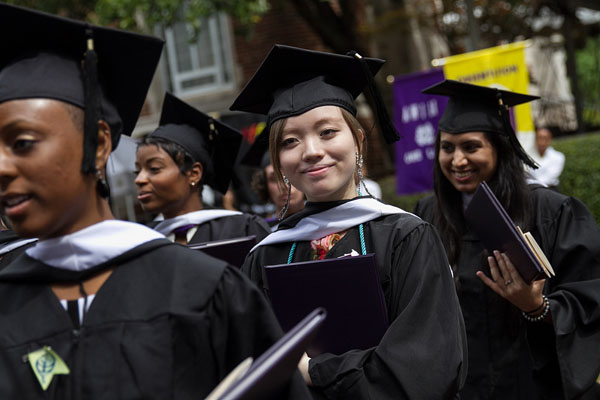They say the two sure things in life are death and taxes. Until recently, never-ending student loans could have been considered a third item on that list. Unlike most other debts, you can’t file bankruptcy on student loan debt unless you’re able to prove ‘undue hardship’, which is nearly impossible unless your circumstances are utterly hopeless.
Many debtors of yesteryear continue to struggle with student loan payments in retirement. Today, however, an end is in sight. New laws enacted and updated over the last few years allow repayment options that will undoubtedly turn out to be nothing short of life-changing for many borrowers (even if they don’t realize it until they’ve been making payments for 25 years or more).
If you’re struggling with student loan debt, you’re not alone and fortunately, there are a number of student loan repayment options that can help.
[cta button=”text for button” image=”http://override-default-image-url” link=”http://override-default-link/”]Get your free monthly credit score! No credit card required![/cta]
Income-based repayment (IBR)
All borrowers with a financial hardship and qualifying outstanding loan balances (Direct, Stafford, PLUS and Direct/FFEL consolidation loans made to students) are eligible to participate. The IBR plan sets your payment amount to 15 percent of discretionary income. That’s the difference between your adjusted gross income (AGI) and the poverty guideline for your family size in the state where you live.
Payments are based on income and family size and change each year. The minimum payment is never greater than the standard ten-year repayment amount. If the calculated payment does not cover the interest charges (on the subsidized portions of the loan), the government will pay the difference for up to three years so that the loan balance does not increase. This program also imposes limits on the capitalization of interest that accrues during deferment or forbearance.
Pay-As-You-Earn (PAYE)
The Pay-As-You-Earn plan is available to borrowers who took out their first qualifying loan (Direct subsidized and unsubsidized, Direct PLUS loans made to graduate or professional students, and Direct consolidation loans without underlying PLUS loans made to parents) on or after October 1, 2007 and who have received at least one disbursement on or after October 1, 2011. The borrower must also demonstrate financial hardship. Some ineligible loans are nonetheless considered when determining eligibility.
Monthly payments are based on income and family size, and change each year. The minimum payment is never greater than the standard 10-year repayment amount. Interest payment benefits are similar to those offered by the income-based repayment program, and capitalization is limited.
Any remaining balance after 25 years is forgiven.
Other repayment options
Graduated repayment allows the borrower to start with lower monthly payments that increase over time, usually every two years. Eligible loans include Direct subsidized and unsubsidized loans, subsidized and unsubsidized Federal Stafford loans and all PLUS loans.
Extended repayment allows the borrower up to 25 years to repay the loan. Eligible loans include Direct subsidized and unsubsidized loans, subsidized and unsubsidized Federal Stafford loans and all PLUS loans.
Borrowers who don’t qualify for the IBR repayment plan might consider income contingent repayment, which does not require a hardship. Payments are based on income and family size and the loan balance is forgiven after 25 years. Eligible loans include Direct subsidized and unsubsidized, Direct PLUS loans made to students and Direct consolidation loans.
Income sensitive repayment is a ten-year repayment plan based on income, with no hardship required. Eligible loans include subsidized and unsubsidized Federal Stafford loans, FFEL PLUS loans and FFEL consolidation loans.
An online payment calculator can show you the different payment amounts you’ll pay under the different plans and the time frame for repayment. For example, a single person in California whose AGI is $30,000 and whose outstanding loan balance is $25,000 at 4 percent interest will pay between $104 (200 months) and $253 per month (120 months) depending on the plan chosen. The highest monthly payment results in the lowest total amount paid. The lowest monthly payment adds 80 months to the loan.
Repayment options are different for Perkins loans; contact your school for information.
Loan forgiveness and cancellation
In some cases, student loans may be forgiven in whole or in part. For example, Direct, FFEL and Perkins loans will be discharged in their entirety if the borrower dies or becomes permanently disabled. But you needn’t take such drastic measures to have your loan reduced.
Become a teacher. New borrowers (as of October 1, 1998) who teach full-time in a low-income elementary or secondary school or qualified educational service agency for five consecutive years can have as much as $17,500 of their loan balances forgiven.
Borrowers employed in public service are eligible for Direct loan forgiveness after having made 120 payments (ten years), even in the PAYE or IBR repayment programs. Public service includes Peace Corps volunteers, U.S. armed forces serving in hostile areas, nurses, medical technicians, law enforcement and corrections officers, Head Start workers, child or family services workers, and early intervention services providers.
Perkins loans are similarly forgiven but in a slightly different manner.
Consolidation, deferment, forbearance
Loan consolidation is another repayment strategy that could help, creating a single monthly payment from two or more. Some consolidation loans also lower the minimum payment by extending the life of the loan to thirty years. The advantage is affordability on a monthly basis. The disadvantage is that the consolidation loan starts the clock over.
Deferments and forbearances allow you to stop making payments for a period of time. Interest continues to accrue, but for those who qualify, the government may pay the interest on a deferred loan. During a forbearance, if you don’t pay at least the interest each month, it will eventually be capitalized. That means the unpaid interest will be added to the loan balance, and then you’ll pay interest on the larger balance for the life of the loan.
Programs are not available to borrowers already in default. If you’re struggling, explore the StudentAid.ed.gov website and contact your loan servicer to discuss options before you stop making payments.
More on Student Loans:
- What to Know About Private Student Loans Before You Borrow
- The College Trap: Are Student Loans Worth It?
- Ask the Expert: Are Student Loans Considered Bad Debt?
- Should You Refinance Your Student Loans?
- Pay As You Earn: Student Loans Just Got More Affordable
- 4 Options for When You Can’t Afford Your Student Loan
Image: Agnes Scott College




















